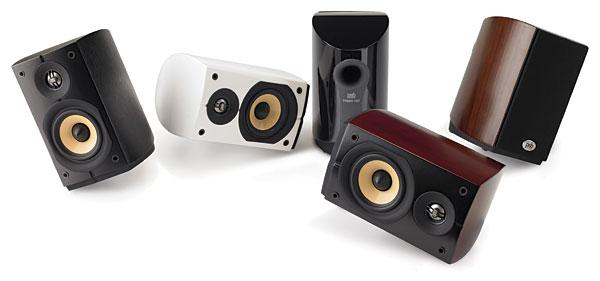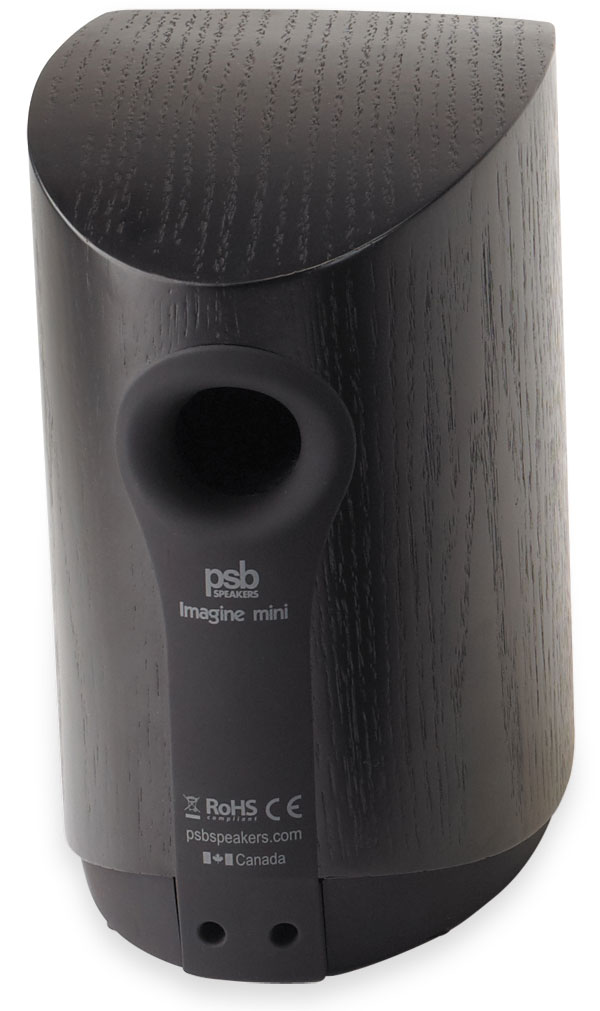| Columns Retired Columns & Blogs |
.

I subsequently met Barton at the 1988 Audio Engineering Society Convention in Los Angeles, and, in the first of many, many conversations we were to have, learned more about loudspeaker design than I had realized there was to learn. (My interview with Barton was published in our October 1997 issue.)
I have reviewed several PSB speakers over the years, but the two that most stick in my memory are the Synchrony One (April 2008 and the Alpha B1 (May 2007). The Synchrony One cost $4500/pair, the Alpha B1 $279/pair, and while I was very impressed with what Barton had achieved with the expensive speaker, I was even more impressed with what he'd managed on what must have been an almost nonexistent build budget. The Alpha B1 had not been out of place hung on the end of very expensive amplification and source components—while it lacked deep bass and loudness capability and ultimate transparency, it communicated the music in an effective manner out of all proportion to its price. Yet when paired with inexpensive components, the B1 was forgiving of any sonic ills committed upstream—as Stephen Mejias can testify, having used the B1s as his "Entry Level" reference ever since we published my review.
Then Came the Mini
PSB's Imagine series represented an attempt to bring the benefits of the Synchrony technology to more affordable speakers. Both Sam Tellig and Kal Rubinson favorably reviewed the Imagine T tower ($2000/pair) in June 2009, while John Marks liked what he heard from the Imagine B bookshelf ($1000/pair) in no fewer than three installments of his column, "The Fifth Element," for that year. Then, at the 2011 Consumer Electronics Show, PSB previewed the smallest, least expensive model in the Imagine series, the Mini. Costing $760/pair in satin-finish wood veneer, or $830/pair in high-gloss black or white, the Mini was one of the hits of CES 2011. Stephen Mejias commented that "the sound of acoustic guitars was enchanting and commanding, with fine detail, impact, and emotion"; Robert Deutsch felt the launch of the Minis to be one the show's highlights.

Measuring just 9.25" high by 5.75" wide by 8.3" deep and weighing 6.5 lbs, the Mini marries the titanium-dome tweeter used in the other Imagine models to a 4" woofer that has a 3" polypropylene cone filled with clay/ceramic materials and a rubber surround. As well as the main ceramic magnet, this drive-unit's motor uses a second, neodymium magnet resting atop the pole piece to multiply the magnetic force factor. The crossover is set at 2.2kHz, with fourth-order Linkwitz-Riley slopes. The woofer is reflex-loaded with a flared 1" port on the cabinet's rear, and electrical connection is via a recessed pair of binding posts on the speaker's base, which is made of hard rubber. Two circular cutouts at the rear allow slim (4mm) plugs to be inserted from behind to reach the downward-pointing binding posts.
The tiny cabinet features curved sidewalls and top panel, and the baffle is finished in matte black. The matching PFS-27 stands cost $300/pair; an extruded aluminum pillar bolts on to a heavy base, while the aluminum top plate is bolted to the Mini's base and locks to the stand. Cutouts in the top and bottom plates allow the speaker cable to be threaded up through the rear section of the single pillar; an internal partition allows the front section of the pillar to be filled with damping material.
Sound Quality
For logistical reasons, I began my auditioning of the Imagine Minis with them sitting on 24" Celestion Si stands, spiked to the wooden floor beneath the carpet and with each stand's central pillar filled with a mixture of dry sand and lead shot. I raised the speakers with upturned Mod Squad Tiptoes so that my ears were level with the tweeter axes, and put Shelby Lynne's Just a Little Lovin' (CD, Lost Highway B0009789-2) in the Ayre CX-5 player's tray.
Well, this was definitely a small speaker. While the upper bass was reproduced in full measure, with tidy control and good definition, the low and midbass were missing in action. Midrange and treble sounded natural and neutral, with good high-frequency extension, though pink noise sounded hollow if I listened with my ears much above the tweeter axes. The soundstage was wide, deep, and stable. However, Lynne's voice in the title track had a slightly "hooty" coloration.

.

The Imagine Mini's are small speakers; ideally suited for desktop or another nearfield experience. As such, and when connected to the NAD D7050 (desktop) amp, and when combined with the PSB 125 sub, I would put these speakers up against almost any floor standing speakers, in an apples to apples comparison, eg, floor standing in a living room and the Mini's in a nearfield environment. For the reviewer to expect that these beautiful little gems were ever going to fill up a room -- especially without a matching sub, was naïve at best. Although, to his credit, the floor stands do insinuate that you could use these in a living room -- but to me that application is more as a subcomponent part of a 5.1, 7.1, etc., system, NOT as the mains.

When my wife and I auditioned these some years ago, we had never heard of PSB. We were sure B&W is what we needed. But these sounded much better and the ability to mount neatly on the wall easily got this over the line for our sensibilities.
OK so its an old review, no problem. But it has many of the tropes of audio reviews, pointless observations when a certain piece of equipment is unsuited to a task that its clearly not intended to fulfil. Important looking charts and graphs that tell you nothing of how it will perform in your environment, only how it performed in a lab test. Or how it compares to "reference equipment" which most of us will never listen to let alone own. I never understand the need to supply this information.
Additionally the reviewer shows they have no clue about how to most effectively utilise these speakers and so makes some unusual assumptions and generalisations while trying to figure it out.
Here's what I've learned as a long time owner. Despite these speakers being around a looong time as I write they still kick butt sonically, when setup right. They are small for a reason and work well in a small space. They will not fill an auditorium, and while they do have a matching floor stand, this is not where they shine. We had them on floor stands for a while, but when we mounted them on the matching wall stands, amazeballs. This positions them where the designers intended and brought them to life compared to using floor stands.
The wall stands take care of the way the wiring is configured as well, something that seems to confound all reviewers. Its a simple thing folks, a neat touch and works as intended concealing the wiring. I managed to easily get banana plugs in there, unsure what everyone else's issue is with this configuration other than its not typical.
Paired with a small sub like the PSB 200, you get full and pleasing sound reproduction entirely suited to a small space. High up on the wall they are well out of the way and pretty much invisible as well in the white finish.
They are not especially efficient, but paired with a decent amp, they light up nicely. You won't get epic dynamics, but you will get a nice smooth clean sound that punishes poorly recorded material, and will bring out things you've not hear before in some recordings. Poorly recorded material will sound truly terrible, flat and lifeless. Well crafted recordings are eye opening, these speakers are quite revealing in that way.
You won't get PA levels of volume of course, but its good to know you can rock the house if you must, especially with a sub.
After some years of ownership, they continue to deliver a satisfying listening experience.

A further observation following environmental changes likely unforseen when these speakers were first reviewed. First the rise of streaming and digital music which has all but seen the demise of the traditional record shop as we once knew it. Vinyl is on the rise for enthusiasts, but digital is largely how things get done these days, either streaming or digitised recordings of some sort. My CD collection for example resides on a NAS as FLAC files.
The next thing is the rise of the single box streaming solution, compact powerful devices that connect all your digital music making it accessible via a mobile device of some sort. And finally, the implementation of room correction software like Dirac.
Imagine all this in one box and you have the NAD M10 in my case, the only input is an ethernet cable and connected to these venerable speakers, elevates them even further. It's a testament to the original design and implementation of these speakers as to how good they sound on the newest equipment all these years later.
Dirac performs some sort of incredible magic with them, sound just comes from everywhere, almost like a pair of Maggies. There is greater detail and dynamics present in music we have been listening to for years. In some cases, the music just soars. It's an interesting experience from two small boxes high on a wall and a small sub which now has its crossover controlled by Dirac. Hence low bass is present and deeply satisfying.
Long story short, all the things that were always very good, now raised to a new level. The PSB Imagine Mini combined with the PSB Sub Series 200 have been an excellent choice. Combined with the NAD M10, it now delivers hours of next level enjoyment.